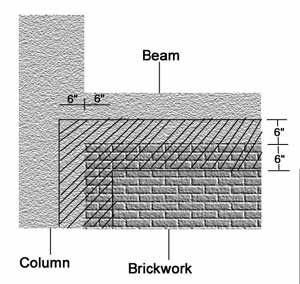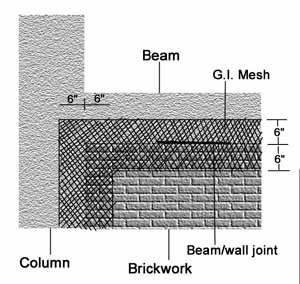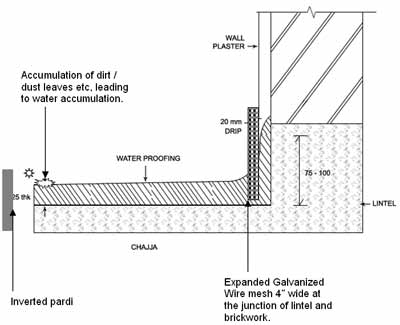| SIDE
WALLS
During the MONSOON it is found
that there is severe leakage through side walls of buildings.
Lack of rounding at the wall end of window weathershed can
lead to seepage through the crack at the wall junction.
• Correct the waterproofing
on all weathersheds as per sketch provided in the section
below for Chajjas .
For damp patch on the
wall refer to sketch 1.

• Chip off loose plaster at
the brick wall. Before chipping mark the plaster patch with
chalk and run a tile cutter 6” away from the outer edge
of the marked patch. This helps to isolate the patch from
the rest of the sound plaster. Then replaster with waterproofing
material.
For beam/wall, column/wall
junction type problem refer to Sketch 2 & 3.
• Fix a galvanised expanded
mesh ½" x 1" diamond shape of 6" wide strip ( 3" on either
side) on wall and beam with plumber nails.
• Replaster the patch with 1:3
cement sand mortar with 1% Superplasticizer. Provide a 6mm
x 10mm deep groove around the repaired portion. After completing
repair plaster, provide a flexible sealant in the groove
to prevent the crack from reappearing.


If the leakage is between the
joint of beam / brickwork or column / brickwork, the plaster
in shaded portion should be removed. As seen in the picture
a galvanized expanded mesh is fixed on either side of beam
/ column and brickwall.
Finally, apply waterproof acrylic
coating to match the present colour of the building.
CHAJJAS
(WEATHERSHEDS / SUNSHEDS)
SUNSHEDS / WEATHERSHEDS show
corrosion damage due to seepage of water from top through
the junction between the brickwall and sunshed. Sometimes
the construction is faulty with inverted pardi at the edge
of the sunshed.
The accumulation of leaves,
dirt and dust causes accumulation of water for days together
and this leads to corrosion damage.

Repair Procedure
1. Remove inverted pardi if
possible. Otherwise provide at least 3” dia PVC pipe outlet.
2. Repair soffit (bottom side
of the chajja) with same procedure as for the procedure
for repairs to concrete damaged by corrosion.
3. Redo waterproofing using
brickbat coba method. The thickness of the coba can be 75mm
near wall end and 40mm at the outer edge.
4. During the making of watta, there is a tendency to complete
the work only with cement mortar. Small brick bats (pebble
shaped) should be inserted in the watta slope to prevent
shrinkage cracks.
5. Provide expanded mesh as
shown in the figure and redo plaster. Mesh can be used when
excessive damage is observed.

|